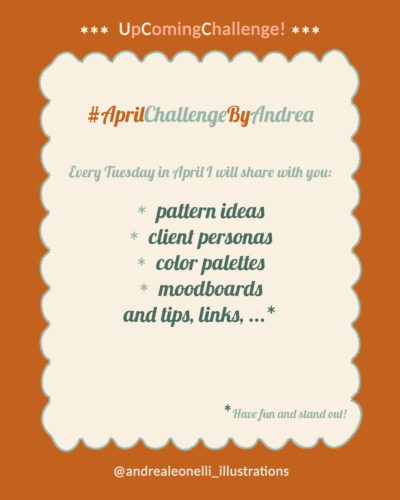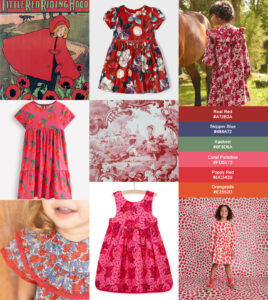I’m launching my first pattern challenge on Instagram!!
This is how I will organize it…and some other thoughts
To begin with
Why this challenge?
Because I’ve never done it before! And I’d love to! So I’m going to try to make this challenge as enjoyable as useful. Ready to get to work? So, here we go!
#challenge
You will have to create a new pattern by freely following the instructions, as a creative game. It’s up to you to make it your own!
How?
***

I’ve organized 4 briefs for the creation of 4 patterns (1 per week) that you’ll find during the 4 weeks of April. Each brief is made up of 4 parts:
- The moodboard
- Your client
- Your mission
- Tips and links (the order may change).
> 4 topics during the 4 weeks of April:
- The first topic will be revealed on April 1st at 8am Paris time,
- The second on April 8th,
- The third on April 15th,
- And last but not least on the 22nd.
Be there to participate or to cheer!
***
My goal each week:
I’m going to focus on the use of the pattern. Too much importance is often given to the pattern quality, without taking into account the use for which it is intended. This is why I think that many very beautiful patterns artistically speaking do not find buyers.
> As a pattern is primarily intended to be applied and sold for a very specific use, it involves three key stakeholders:
- the person who needs the pattern (the POD company, the small business, the fabric company etc.)
- the person who will purchase the final product (the wallpaper, the clothing, the fabric, etc.)
- the person for whom the final product is intended (this is often the same person as before, but not always).
#challenge
During these four weeks of challenge, I will imagine personas, imaginary customers and their needs (business context) in order to target objectives.
Your client
Your client wants to know you and how you work!
I’ve been asked several times to show my work in progress, and… I had nothing to show! It’s rather a shame. It’s important for clients and collaborators: they want to see how you work! We don’t all have the same universes, the same techniques, or the same way to use tools. So that’s what will set us apart! You have to show it, not only for socials and followers, but also to reassure your client/interlocutor who doesn’t know you! To be honest, I don’t do it yet, I really need to get on with it!
It’s not about impressing the competition or revealing trade secrets, but it can also help you gain perspective on your own work and strengthen its long-term consistency. So make photos, videos, timelapses etc, show your studio etc… Many tools exists, find yours, choose the one that suits you! I sometimes use Canva. Easy and clean.
#challenge
During these four weeks of challenge I encourage you (and me too) to share your processes #wip!
***
Know your customer as well
Who is your client? A one-time buyer who found your design on a POD platform and loves your colorful world? A small business with specific needs that prints in small batches and wants to license a collection? A large company that needs simple, quick-to-make (and therefore inexpensive!) patterns for items that will only last one season? Knowing your client will allow you to set clear guidelines and present the appropriate work (Fast, simple and few layers or complex, personal and available in several files).
#challenge
By the end of these four weeks, I hope we’ll all have four additional patterns ready to be licensed or become successful in our catalog!
***
✨Makers and small businesses!✨
“I look forward to your participation and support!”
Need a new pattern for your summer collection or your children’s outfits? Have you been looking for a pattern for a long time and still haven’t found what you’re looking for?
📩 Leave your comments or requests/ideas in a message and don’t hesitate to contact the designers of your choice (we’re always happy to hear from you).
You
Know & assert yourself
What makes you unique? whether it’s style, personality, history, the way you stage or present your work, technique, etc. In these uncertain times, faced with competition and the rampant use of AI, it’s the artist personality that make the difference and must prevail. A pattern is often successful not because of its perfection, but because of the emotion it arouses. That impression we have when faced with the work of a craftsman or an artist, and which we do not find when it is designed by a machine or a mechanical act.
My added value…
What do I hope for from this challenge? That everyone will embrace the stories, colors, and ideas I’m going to share with you. That everyone will be able to go further and explore new avenues. That everyone will be able to create their own unique design, the fruit of their personality, their journey, their story… without competition, and that you will assert yourself as an artist.
#challenge
For this challenge I will ask you each time to call upon your tastes, your memories, …everything that can make your pattern at the end yours and not just anyone’s.
Moods & colors
Make a moodboard
For every project, the first step is to create a moodboard. This board will be composed of the client’s expectations (and needs), as well as your own inspiration. It’s the meeting of two different aspirations that will need to converge to result in a pattern design that will ideally suit you as much as your client!
Make a palette
Taking someone else’s palettes isn’t very interesting. During this challenge, I’m only going to give you palettes as a guide, on the condition that you take them and arrange them and adapt them to your moods, style, etc. I don’t use palette generators. I just look around.
Funny tip: You can take an inspiring photo (your last vacation!) and open it in a drawing software, use the pixelation>mosaic filter to obtain color tiles from which you can pick a few shades.
There are endless ways and tools to create a color palette, here are a few links:
#challenge
This is why I propose for this challenge to provide for each week a moodboard which will serve as a guideline, you are free to follow it, to be inspired by it or to recreate a new one. Keep at least one dominant color from the palette. The patterns will be grouped into a collection on spoonflower, so customers could use the theme and colors to coordinate patterns or for quilting projects, for example.
Trends
It’s just part of the game!
Whether you want to follow trends or not, they exist, …why would you ignore them? If you want to work in the fashion world, for example, ignoring trends would be shooting yourself in the foot. Everyone is subject to trends, we see them pass before our eyes every day, while walking down the street or in stores, on our screens and magazines, on the clothes of the people around us, at our friends’ houses, at the cinema…
There are so many trends coexisting that there’s always a way to find one that works for us. I take it as general knowledge, a thermometer of the world we live in.
Because you don’t really need someone to tell you that the next trends will be rabbits in April, mushrooms in autumn, and snowmen at Christmas…I suggest you to follow trends forecast by specialist agencies and encompassing other exciting sectors such as architecture, design and lifestyle. “Their unique approach merges sociological studies, marketing strategies, and artistic creativity”
About current trends (links):
***
More tips and links each week!
***
Now, let’s go to the challenge and enjoy! I can’t wait to hear what you think of what I’ve prepared; I hope you’ll find it interesting. See you on April 1st!
